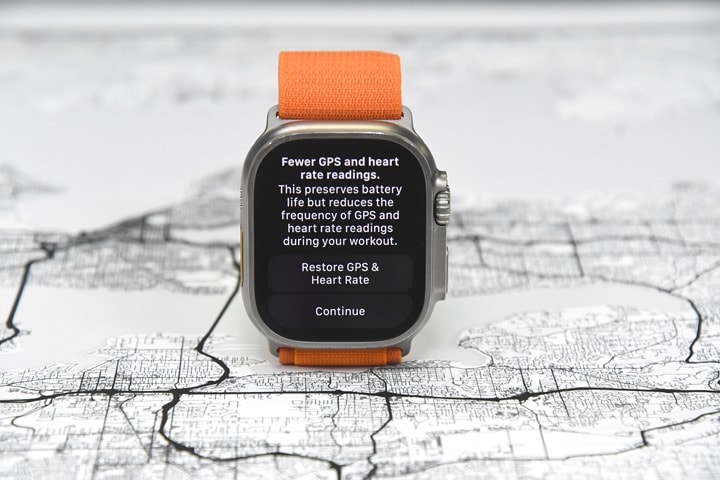
When the Apple Watch Ultra was announced last month, it included an initial lower-power mode across the entire watch that mostly just reduced some background features while preserving workout fidelity. Meaning, heart rate and GPS sampling rates remained the same at 1-second update rates (the industry standard). In this initial low-power mode, Apple claimed you’d have enough battery for most people to finish an Iron-distance race, whereby the average for that is about 15 hours. And indeed, in my testing, I went out and did a 14-hour trail run/hike and finished with about 15% battery remaining in this mode.
However, at announcement they also promised a secondary lower-power workout mode “later this Fall” that would reduce the GPS readings to once every 2 minutes, and heart rate readings to once every 1 minute. That new mode was released today as part of watchOS 9.1. In that mode, the unit would achieve up to 60 hours of battery life. However, that isn’t 60 hours of GPS battery life, but rather 60 hours of smartwatch-life, including other tasks, specifically:
“Hiking, walking, or running workout, over 600 time checks, 35 minutes of app use, 3 minutes of talk, and 15 hours of sleep tracking. Usage includes on-demand LTE connection and 5 hours connected to iPhone via Bluetooth over the course of 60 hours.”
And then within this new mode, the following changes are made:
– Turns off always-on display
– Reduced cellular connectivity to only update hourly
– Makes cellular on demand when not in range of your phone
– Limits background features including irregular heart rate notifications and auto-workout detection
– Reduces heart rate to once per minute, and GPS updates to once every 2 mins
– Reduces distance and pace updates to once every 1-2 minutes (varies slightly)
– Turns off running power (entirely)
– Turns off all running efficiency metrics (e.g. vertical oscillation/ground contact time)
– Reduces altimeter readings
– Turns off splits and segments
– Turns off alerts
So to recap, you’ve got basically four levels:
Normal usage/mode: 36 hours of smartwatch battery life
Normal usage with workout mode: 12 hours of GPS battery life
Low Power Mode (full workout fidelity): Roughly 15 hours of GPS battery life
Low Power Mode (reduced HR/GPS updates): 60 hours of smartwatch battery life
So, how much actual GPS workout time is this new mode? Well, unfortunately, Apple won’t make any claims there. And despite my recent history of going out and hiking/running till various products die (including testing the Enduro 2 this past summer, 8 days of Alps hiking later), I don’t exactly have time this week to go out and run/hike for umpteen hours till this thing dies.
However, what I did learn from my previous Apple Watch Ultra battery test is that the battery decline rate is extremely predictable. During my 14-hour hike with the first lower mode, I kept hourly notes on the battery burn rates. And for almost the entire day it burned very consistently at 6-7%/hour. The one exception was a single-hour mid-day where it randomly burned 14% for no obvious reason. However, that 6-7% realm matches what others have seen as well, again, in the full-fidelity workout mode.
Testing it Out:
So, what about this new lower-power mode? Well, let’s do some easy tests. First, to enable it – which, does require you to download the latest WatchOS 9.1 update, which will only also show up once you download the latest iOS update – both of which released today. Once you’ve got that installed, under the workout settings within the ‘Watch’ app on your phone, you’ll see the new “Fewer GPS and Heart Rate Readings” option:
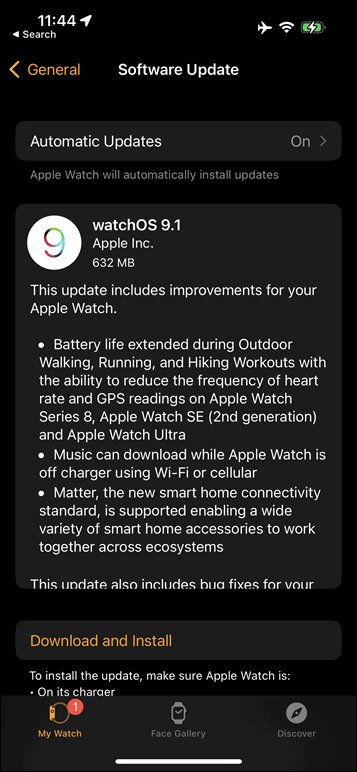
![clip_image001[6] clip_image001[6]](https://media.dcrainmaker.com/images/2022/10/clip_image0016_thumb-4.png)
When you do so, it lists a partial list of things in the app, but as I’d discover, that’s actually not the whole list. Instead, you have to go out and run and realize what’s missing. For that, I’ve included everything I could figure out in the list above (including things like no running power).
With that enabled, I went out for an adventure. In this case I specifically left the phone behind – but remember the 2022 Apple Watch units (Ultra/Series 8/SE 2nd Gen) no longer leverage the phone connection for any GPS usage anyway. That’s all on-device now. As with before, I don’t have LTE enabled on my Apple Watch Ultra.
When you start any run/walk/hike (the only activities this pertains to), it’ll warn you again you’re about to go into low-data-stinky-mode, and offers to get you back on the straight and narrow:
![clip_image001[13] clip_image001[13]](https://media.dcrainmaker.com/images/2022/10/clip_image00113_thumb-1.jpg)
For this test, I ignored that, and off I went:
![clip_image001[17] clip_image001[17]](https://media.dcrainmaker.com/images/2022/10/clip_image00117_thumb-1.jpg)
Now, I’m not going to bore you with iterating through the entire run. Instead, I’ll make some quick observational things, and then some data things.
A) Pace/Distance/HR: While running you lose any instant pace/distance type and HR metrics, instead, these are updated roughly once every 60 seconds for heart rate (showing the most recent HR snap at once per minute). And then for distance, you’ll get those updated roughly every 90 seconds from my testing. It wasn’t actually every 2 minutes from the GPS update. This is interesting, as I’d have expected it would use wrist-based accelerometers for continually updated distance (like every other watch on the market), but in fact, it doesn’t, it just updates every 1-2 minutes. You can see this below in these two photos I took, about 70 seconds apart, and the distance and HR remained the same (despite running the entire time):
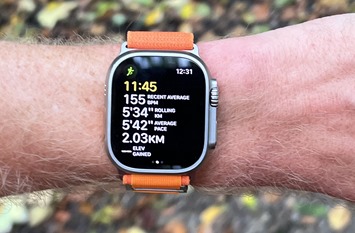
![clip_image001[6] clip_image001[6]](https://media.dcrainmaker.com/images/2022/10/clip_image0016_thumb-2.jpg)
B) Running Power/Advanced Metrics: My running power data pages configured for that run profile went away entirely, as did the post-run running power data. Further, all running efficiency-related metrics are gone – both the mid-run data pages as well as post-run data pages.
C) Altimeter: My barometric altimeter elevation page didn’t seem to update very friendly either. In some cases, it was once per minute, and in other cases it went a number of minutes between updates.
![clip_image001[15] clip_image001[15]](https://media.dcrainmaker.com/images/2022/10/clip_image00115_thumb-1.jpg)
D) Splits: As noted, you’ll get no splits during the run, but you will get splits post-run, though, they won’t be accurate.
E) Heart Rate Strap: Fun fact: If you have a heart rate strap paired via the Bluetooth menu on the Apple Watch, it *WILL* use that at full fidelity (every second), which is cool. I would expect zero battery hit there, since BLE sensor pairings are (by design) incredibly lightweight from a battery impact standpoint, and in virtually every device there’s considerable savings using a BLE/ANT+ chest strap over an internal optical HR sensor.
![clip_image001[11] clip_image001[11]](https://media.dcrainmaker.com/images/2022/10/clip_image00111_thumb-2.jpg)
However, the real interesting bits is just how much distance you’ll lose. In my case, my route wasn’t super complex (read: not a mountain switchback route). But, it was a route with both some nice straight sections where lack of GPS updates didn’t matter much, but also some nice forest sections where it entirely misses everything. And while I have plenty of neat comparison charts to show you, the best way to illustrate this is actually Apple’s own map screenshots, as it handily puts dotted lines for all the sections the GPS is off, and then simply connects the dots:
![clip_image001[8] clip_image001[8]](https://media.dcrainmaker.com/images/2022/10/clip_image0018_thumb-4.png)
![clip_image001[10] clip_image001[10]](https://media.dcrainmaker.com/images/2022/10/clip_image00110_thumb-4.png)
![clip_image001[12] clip_image001[12]](https://media.dcrainmaker.com/images/2022/10/clip_image00112_thumb-4.png)
![clip_image001[14] clip_image001[14]](https://media.dcrainmaker.com/images/2022/10/clip_image00114_thumb-2.png)
Now in theory, if there’s a phone connected with Apple Maps access, it does some snap-to-route type stuff. But I didn’t have that connected mid-run, and it didn’t snap to route post-run. Realistically though, if you’re trying to eek out every bit of battery on this watch for a 20hr+ adventure, then in my most cases you’re also likely to be trying to eek out battery on your phone, and probably have connectivity turned down/disabled to preserve battery life.
In any case, you can see the impact of the GPS tracks in the comparative maps (here’s the full link if you want to dig deeper):

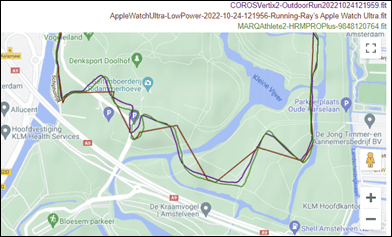
And again:
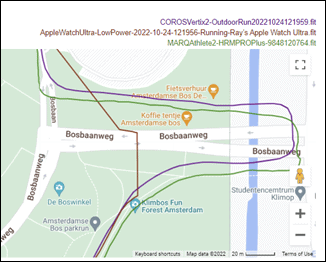
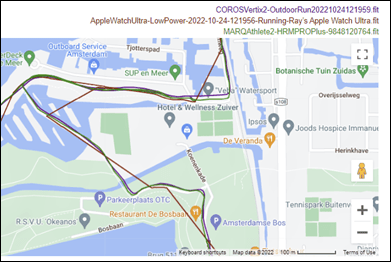
Obviously, it cuts corners like nobody’s business. Entire out/back sections are missing. Rosie Ruiz would be proud. As for the final distances:
Apple Watch Ultra (Lowest Power Mode): 10.54KM
COROS Vertix 2 (Multiband): 11.66km
Garmin MARQ Athlete 2 (Multiband): 12.00KM
Suunto 9 Peak Pro (All Systems): 11.94KM
Finally, what about battery life of the Apple Watch? Well, that’s apparently trickier. In my case, I started an hour-long run with 86% battery…and…umm…ended the hour-long run with 86% battery. Obviously, it burned some battery, but I apparently stayed within the rounding errors of that to basically be 1% or under. I noted that Dave from Chase the Summit got 1% burn on one of his one-hour trail runs.
And while all that might sound impressive – let’s keep in mind the watch is basically entirely in a low-power-almost-sleep-mode for pretty much all but 60 seconds of ‘work’ out of the entire hour. In reality, it’s certainly a bit more than that, but practically speaking, the amount Apple has turned off here makes this kinda a non-usable situation. If we compare to companies like Garmin, COROS, and Suunto, their low-power modes are still relatively full fidelity except for the GPS sampling rate. But everything else (including distance/pace/HR updates) is all mostly at 1-second intervals. And Garmin’s Fenix 7 Solar can nail an astounding 289 hours in that mode. The Fenix 7X Solar? 578 hours. And dare I mention the Enduro 2? 714 hours!
Wrap-Up:
![clip_image001[9] clip_image001[9]](https://media.dcrainmaker.com/images/2022/10/clip_image0019_thumb-2.jpg)
My point here is that for *sports* usage, the new lower-power mode isn’t super helpful. Instead, the mid-tier lower-power mode that doesn’t sacrifice any data depth is where you want to be (and if you really need to make some battery savings there, connect a HR strap instead).
However, as with most things Apple – the benefit of certain features isn’t always endurance sports. Instead, it’s part marketing, and part more casual scenarios. If you just want better battery life in general, and don’t care about data depth, and aren’t moving all that fast, then for casual walks, the data losses aren’t that big a deal. Especially if you have your phone with you so Apple Maps can do some magic.
Either way, as I’ve said many times about the Apple Watch Ultra since its release: Judge the future of this segment not by Apple’s initial trials and tribulations, but instead, where they are in about 12-18 months. It’s been just over a month since the Apple Watch Ultra started shipping, and this is the first of a number of planned sports-focused feature updates this year alone (still including a race pacer mode, track mode, and more). Some of these new features they’ll get right on the first go, and some of them will need to go back for more refinement after user feedback.
With that, thanks for reading!
Found This Post Useful? Support The Site!
At the end of the day, I’m an athlete just like you looking for the most detail possible on a new purchase. These posts generally take a lot of time to put together, so if you're shopping for the Apple Watch Ultra (Alpine Loop Orange) or any other accessory items, please consider using the affiliate links below! As an Amazon Associate I earn from qualifying purchases. It doesn’t cost you anything extra, but your purchases help support this website a lot.
Since the Apple Watch Ultra (Alpine Loop Orange) is no longer sold, I recommend looking at its successor, the
Apple Watch Ultra 2:
And of course – you can always sign-up to be a DCR Supporter! That gets you an ad-free DCR, access to the DCR Quarantine Corner video series packed with behind the scenes tidbits...and it also makes you awesome. And being awesome is what it’s all about!












![clip_image001[6] clip_image001[6]](https://media.dcrainmaker.com/images/2022/10/clip_image0016_thumb-4.png)
![clip_image001[13] clip_image001[13]](https://media.dcrainmaker.com/images/2022/10/clip_image00113_thumb-1.jpg)
![clip_image001[17] clip_image001[17]](https://media.dcrainmaker.com/images/2022/10/clip_image00117_thumb-1.jpg)

![clip_image001[6] clip_image001[6]](https://media.dcrainmaker.com/images/2022/10/clip_image0016_thumb-2.jpg)
![clip_image001[15] clip_image001[15]](https://media.dcrainmaker.com/images/2022/10/clip_image00115_thumb-1.jpg)
![clip_image001[11] clip_image001[11]](https://media.dcrainmaker.com/images/2022/10/clip_image00111_thumb-2.jpg)
![clip_image001[8] clip_image001[8]](https://media.dcrainmaker.com/images/2022/10/clip_image0018_thumb-4.png)
![clip_image001[10] clip_image001[10]](https://media.dcrainmaker.com/images/2022/10/clip_image00110_thumb-4.png)
![clip_image001[12] clip_image001[12]](https://media.dcrainmaker.com/images/2022/10/clip_image00112_thumb-4.png)
![clip_image001[14] clip_image001[14]](https://media.dcrainmaker.com/images/2022/10/clip_image00114_thumb-2.png)




![clip_image001[9] clip_image001[9]](https://media.dcrainmaker.com/images/2022/10/clip_image0019_thumb-2.jpg)
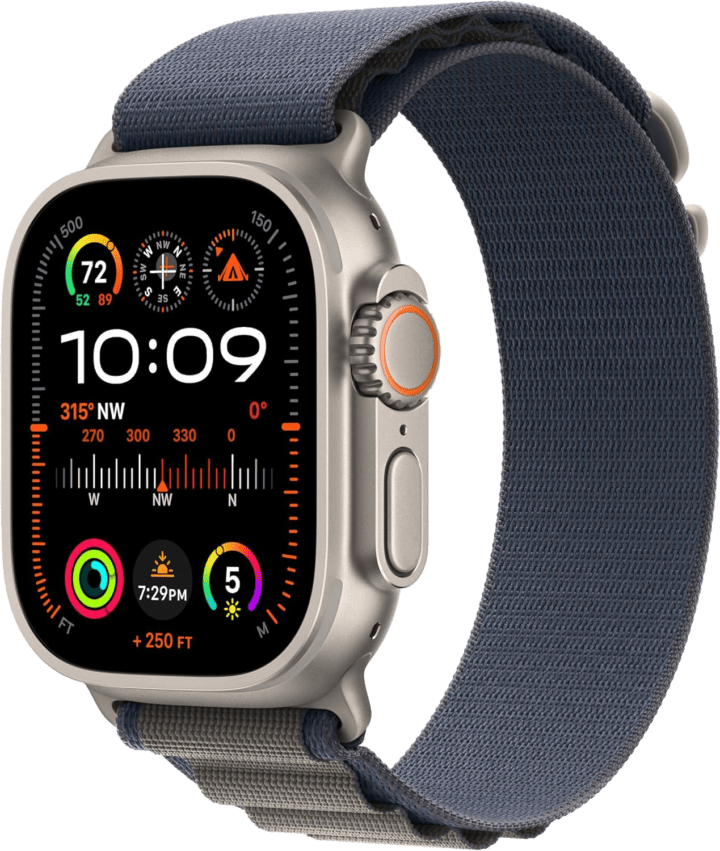













Thanks for doing the hard work for all of us.
Looking forward to Apple continuing to update sports focused features. As an avid runner my Ultra has been great.
Thanks for being a DCR Supporter!
Thanks Ray. I’m holding off on getting the Apple Watch for a year or two to allow them to mature as a sportswatch I can use. I’m actually looking at it as a phone replacement during my rides. My Fenix 6 is already an overkill as is so I’m in no rush to get another shiny toy. I’m actually waiting for the solar panels to mature more on the Fenix as well. All these new things are really just shiny objects now. We’ve got so much data that we normally ignore them all after a few days or weeks🤣
How often are the HR readings in normal mode?
> “full fidelity (every second)”
Same as with an external sensor.
Super-ultra marathoners are a rare breed but more common are lowly day hikers like myself. Perhaps if someone anticipates doing huge 14+ hour hikes that won’t support a normal mode, and don’t want to make allowances for charging the watch during a break this mode wouldn’t be so bad. Perhaps the GPS updates being every minute or two won’t be bad if you are moving slower (walking) as compared to trying to use it while running? I agree this isn’t a real solution for dedicated through hikers or ultra marathoners without real access to charging etc.
Yeah, if moving slower (walking) on a straighter course, I don’t think you’d see a massive difference. However, for any switchback type scenario, even walking, this would be pretty tough with the 2-minute update rates.
But as always, not everyone is in the mountains. Here in the Netherlands, the vast majority of routes one would do are fairly straight for long periods of time, and realistically, in that scenario you’d have relatively minor losses.
Rosie Ruiz – Nice reference. 🙂
:)
Thanks for being a DCR Supporter, Bruce!
Good to see things moving ahead at pace with the Ultra’s updates. I sent mine back after about 10 days (and got a regular Series 8 for daily wear instead) – it was really nice as an Apple Watch, but would have been little use on the 25km I ran in the forest away from my home town this weekend, with a load of new trails and switchbacks I couldn’t route along to my destination. As Ray says, when Apple get to the point where integrated navigation equals what’s available on my Fenix 7X, I’ll probably switch for good. It’s a good way off yet, though.
Dave, do you ‘use’ the Garmin training metrics such as Body Battery and Training Readiness or do they just not matter to you? I’m thinking of going AWU for daily use and then that PLUS my F7XSS for sleeping and working out to try and at least maintain some consistency with the Garmin advanced metri cs.
I do take note of them, but I’ve started to wear my Series 8 for sleep as I find the detail level a little more to my taste. Athlytics on the Apple Watch has also been interesting to compare to my Fenix 7XSS body battery, etc. Effectively I’m doing exactly as you plan to, bar keeping the AW on at night time as I find it a lot more comfortable to sleep with on the wrist. I don’t mind switching between the two as I did it for many years with a “normal” watch and my old training watches (including the FR305 to the 920XT with various old Polars including the S625X, RS800SD and RCX5, and a few from Suunto mixed in). Hopefully at some point we’ll see Garmin able to include more “smart” stuff or Apple meet them in the middle with recovery metrics and structured plans, etc.
Thanks for the reply. I’m actually thinking of training and sleeping with both but using the AWU as my daily.
I think there is a better chance that Apple will add the fitness features than Garmin break through on the smart side. Apple just won’t allow that.
Todd, I’ve done what you’re contemplating this summer, but with an AW 6/7 during the day and a Garmin 955 for sleep and workouts. As far as I could tell the only factor you’re missing for recovery data if you don’t wear the Garmin during the day is stress history.
So, which did you stick with?
I’ve been primarily using the AW for daily wear and workouts since I’m in a recovery mode, but I assume I’ll start wearing the 955 for workouts and sleep once I start marathon training again at the start of the new year.
I think the AW if fine for easy running and general exercise, but when I’m training for a race time I like having my workouts and runs recorded with a Garmin and fed into Garmin Connect.
Agreed.
How big of a problem is loosing data details?
Yes, you loose on accurate distance, but most ultra’s is not about how far you can run in 24 hours but how fast you can go over a given parcours.
Like wise, how interesting is it for ultrarunners to know their heartrate on a second interval?
People are obsessed with data and just want more of it.
Although I don’t think many ultraruners would opt for an applewatch. The elite just wear what their sponsor provides and non elite wear what their hero’s wear or what produces to most data. So garmin will be king for some while.
Setting aside that most Ultra runners wouldn’t choose this watch, I’d argue distance is actually super important in Ultra racing – arguably the most important thing. Without knowing accurate distance, you have no idea how to pace, or your timing.
In my relatively straight course, it was short by about 10-12%. On a heavy switchback course (e.g. UTMB), I’d guesstimate you’re talking being short 30-40% (easily). Thus, you’d think you’re moving far slower than you actually are.
Certainly, there are plenty of more advanced things, but I’d argue that roughly accurate distance is sorta the singular reason you buy any GPS watch, even a $50 watch.
If you want accurate pacing you don’t want gps. A footpod does a better job.
Pacing (e.g. exact pace) is different than understanding your current distance and how you plan to pace your efforts.
Either way, modern GPS with multiband is astoundingly accurate these days, and I’d argue on many of these switchbacks with steep inclines, it’s probably going to be more accurate than most footpods which often struggle in that type of terrain because it’s not super predictable.
Fair enough.
hypothetical discussion anyway. I’m neither in the market for an Applewatch nor for an ultrarun.
I have been waiting to afford one for the past 4 years! 🤦🏻♀️
Maybe one day! ☀️
Insightful article.
I was interested in this 9.1 update & real-talk as to what it does. Gracias!
Based on your numbers and Chase the summit, you’d expect expect the total hours to be about 100, and more realistically around 80ish I would guess after everything was said and done. If they increased frequency of GPS to every to every 30 or 40 seconds, maybe they could hit 30 hours with improved accuracy that could actually be used. I don’t know if Apple would actually give options like that, but would be good to see for
I wonder if I’m the oddball, but I’ve never enjoyed the always on display. for one, you get screen burn in from your most common watch face (ask me how I know) and second, it kills battery. Cutting that feature off I regularly wear my apple watch 5 for two days without charging, and it seems to help a lot with workouts as well.
that said, this low low power mode does seem a bit extreme. if you are hiking up a mountain in one direction it might be ‘good enough’ data fidelity, but otherwise yea I can’t really see what type A athletic person is going to want to lose that much accuracy on a super long endurance outing. I’m still recovering from completing unbound 200 but my wahoo crashed middle of the race so my track only shows 198 miles /cry
Ray,
Great information, and helpful. I’ve had the Ultra since its release and without any power saving modes am getting a little over 2 full days, approaching 3. Not a lot of GPS use as my runs are short, about an hour a day. But it’s burning full LTE and music as I don’t carry a phone with me anymore. Also another 1 to 2 hours on stair climber, indoor bike and pool swimming.
I think the low power modes would only be useful for endurance/long distance stuff. I don’t see where it’s useful for someone who can charge the watch the morning of the 3rd day and isn’t an “ultra” athlete.
Great read. It’d be better to test this out with WorkOutDoors to see if that works better since the maps are downloaded upfront.
I get that Apple will be improving all of its metrics and refining perhaps how much battery life can expect in all modes. However, I got the current Ultra. My concern is will it need a new watch in the next 3 years in order to take advantage of the new features, or is it likely that the current watch would handle that.
A great review
15h is already enough for 99.99% of the people out there. If you need real battery life you have to use a Coros. What’s left for the Garmin fan boys or ambassadors?
Is there a similar to Garmin’s pace pro functionality? Although stated in some sites I also do not find a run a previous race option with love Delta’s or every Km.
No, nothing like that natively. There’s some upcoming pacer-type functionality, but it’s not of the pre-planned nature like Pace Pro. Rather, it’s more about comparing to previous efforts.
Is it possible, or ‘practical’ to put in a “$dollar per hour” for such ultra mode comparisons?
Apple watch ultra US$,1200
Garmin Fenix 7 solar is US$800
Enduro 2 is about US$1,100
Obviously (though not always) a more expensive watch should have better battery life though features vary.
I’m asking because trying to put in some form of ‘weighted’ elements of each watches features, including price, may come up with some indicator of value and trade offs users may like to think about.
I think that’d be tough, as it assumes battery life is key to some people, when in reality, for many Apple Watch Ultra owners, they’re just looking for an extra day of smartwatch/standby battery life – rather than the many hours of GPS life.
Yeah, exactly, that’s me. I don’t really care about battery life; what the watches can do is far more important. I pop my Ultra on the charger every night just like I’ve done with every Apple Watch I’ve owned (I started with the series 0, the original). The Ultra has figured that out, and only charges to around 80% now (the first time it happened there was a message on the watch telling me that is done to prolong battery life). For real activities, I use Garmin devices, which are far better than the AW for that. The only battery life consideration I had when I got the Ultra is that in two years I may not have to pop it on a charger during the day to get it through the day like all of my previous Apple Watches. I hope the Ultra will go 4 years before I start having battery problems.
Will this low power mode work with the app “WorkOutDoors?” I’m doing a 50 miler next month that will take me between 10-12 hrs. Tempted to start in normal mode and switch to low power mode 2/3a through. Is that what you’d recommend?
Thanks always!
I’ve been wondering about this as well. Especially as I am probably missing an easy button somewhere but I have not figured out a way on the AWU itself to drop from low power full workout fidelity down to power sipping mode low power reduced HR/GPS. Just like you, I’d like to have the option to do this from the watch without getting to a phone.
That said, I regularly use low power through watchOS, and I’m an avid WOD user. I’ve been paying closer attention with an event coming up, and my data shows WOD recording activity, watchOS low power full workout fidelity at about 8.5% burn rate per hour. If I flip off cellular (in addition to low power full fidelity) it burns closer to 7% per hour. I haven’t used the native app much but I think WOD itself isn’t burning at a noticeably higher or lower rate than the built in app based on the numbers I’ve seen reported.
So at what point would you say you no longer need an Edge device
How could this, or any other watch, ever replace an Edge? I now use a 1040 and I’m spoiled for life with the large screen (up from an 830). A watch has a tiny screen, mounted in the wrong place, and an Ultra is much less capable than an Edge. I would never use my Ultra, or any other watch (I have a Fenix 5+) for cycling unless something went seriously wrong and there’s no other choice.
Yeah, I think it ultimately depends on how frequent you ride.
For most people that ride enough, no watch will replace a dedicated bike computer. Just in terms of wrist visibility alone, using a bike computer is always-there, since in most riding positions for road/triathlon, you’ll have out-turned wrists. For MTB it’s a bit better, but that’s counteracted by you usually needing to pay a bit more attention to the trail.
I have an Apple Watch 8 and have been trying to figure out how to maximize battery life for an upcoming 50k (I estimate about 6 to 8 hours). Your overview is really helpful. I reposted it below for easy reference.
1. Normal usage/mode: 36 hours of smartwatch battery life
2. Normal usage with workout mode: 12 hours of GPS battery life
3. Low Power Mode (full workout fidelity): Roughly 15 hours of GPS battery life
4. Low Power Mode (reduced HR/GPS updates): 60 hours of smartwatch battery life
Based on your results, it seems option 3 is the way to go (minimal loss of function, full fidelity on workout data). Further, option 4 should be avoided and Apple should have designed it not as a regular mode but, rather, as an optional setting that only kicks in when the battery life is actually at something like 10-20%. Unfortunately, it doesn’t appear to be possible to start in mode 3 and then automatically switch to 4 when needed.
Probably these are obvious suggestions, but things to consider.
1. Don’t listen to music via Bluetooth
2. Turn off LTE cellular (via control center)
3. Use an external heart rate monitor (the consensus seems to be that heart rate via Bluetooth consumes less power than lighting up the watch’s own LEDs, but I haven’t seen that thoroughly tested, so you could use a few training runs to verify)
4. Turn off “Always On” and “Wake on Wrist Raise” for the watch display (you’ll have to tap it to turn it on)
With those settings, I could eke out 4-5 hours from my 41mm Series 7 with WatchOS 8 (before low power mode was available).
Thank you for these additional suggestions. Just quickly on your notes:
1. Music: I always take my phone for safety so typically listen to audio via phone not watch. Not sure if listening on phone though, impacts battery life on watch. Will investigate.
2. LTE/WiFi: Before your comment didn’t realize Low Power Mode does *not* turn of WiFi (I don’t have LTE) so will be sure to do that manually.
3. External HR: Am using Polar Verity Sense external HR monitor. I originally got it for swimming but am pleased it’s proven useful for running.
4. Screen: In past have sometimes turned on Theater Mode to disable Always On & Wake on Wake Raise. Low Power Mode turns off Always On but not Wake. I like Wake on Raise for pacing but it can also be a bit too tempting to check constantly. Will play it safe for 50k and follow your advice to turn off both modes.
Thanks again!
In case it is helpful to anyone else, an update from my first 50k run that I finished in a slow 8 hours and 12 minutes.
— I used Low Power Mode
— I used a Polar Verity Sense for heart rate data connected by bluetooth
— I manually turned off wifi and turned on Airplane Mode (not sure Airplane Mode turns off anything else)
— I decided *not* to use Theater Mode so that I could check HR easily
— Apple Watch Series 8 started with 99% and ended around 7%
— GPS and HR resolution look excellent
In sum, an Apple Watch Series 8 with Polar Verity Sense can record ~8 hours of high resolution GPS and HR data but anything much longer than 8 hours is probably cutting it close and you should probably use an Apple Watch Ultra or Garmin, etc.
Another ~50k with an Apple Watch 8, 41mm. Total race time was 7:01 hrs and battery went from 100% at start to 11% at finish. Options used:
— Low Power Mode
— Polar Verity Sense for HR via bluetooth
— Theater mode to minimize screen usage (I have to manually push button or screen)
— GPS and HR resolution are fine (My course distance came up a little short but could be because I ran straighter lines than exact curvy route)
— I *did* listen to music the whole time
In short, the Series 8, 41mm is enough for a hard 50k but just barely. Will probably upgrade when Series 10 launches in fall. Don’t think I need the oomph of an Ultra but it’s an open question how much additional battery life would come from a Series 10, 45mm.
I pushed my AWU further than I ever have yesterday. 11 hour hike/trail run. I had it in low power mode and airplane mode the whole time. I also had my iPhone with me in airplane mode.
I started with around 95% and ended around 20%. That seems like too much battery use for low power mode.
I did have it paired to a Bluetooth heart rate chest strap. Is that likely where I was burning extra battery?
I’d agree, that seems a bit higher battery burn. Especially as the HR strap would have considerably helped (not hurt) battery burn. And even more in low power mode, it should have been WAAAAY more efficient than that.
My only two thoughts would be:
1) Beta or prod?
2) Potentially one or more 3rd party apps in the background doing weird stuff.
It also might have been the phone in airplane mode. If there’s something on the watch trying to make an Internet connection (weather app?), it wouldn’t have been able to do it. It may just keep trying and trying.
Here’s the “fun” adventure. link to strava.app.link
I realized about 2/3 of the way through that I had the crown button enabled for Siri. I didn’t have the watch screen locked so every time I had to put my hand down on something to get up or down a ledge, my wrist would push the crown and try to open Siri. I bet that burned some battery.
I also probably forgot to close all of the other apps. Is it enough to close apps or should I try to delete a bunch of stuff that I don’t use off of the watch? I could also use a simple watch face with no complications?
Either way, almost 11 hours in the standard (high sample rate) low power mode with 20-25% still left isn’t too bad. I guess doing the math that would get me to around 14-15 hours if I ran it down to zero.
Interesting.
In my case, mine was effectively airplane mode as well, as it was paired to a different phone that I didn’t take with me on the ride.
Still, mine was not low-power mode, so I’d have expected yours to be higher than that given the low-power settings.
Just checking. Isn’t 15 hours the expectation for actively using GPS in low power mode with the normal sampling rate?
Low Power Mode (full workout fidelity): Roughly 15 hours of GPS battery life
Total elapsed time was 10:15ish. (Strava thought all those times when I was scrambling up and down ledges were rest breaks 🤪!) Started with 95% and ended around 20%. That gets me towards 14 hours. Not all the way to 15 but close.
This is the best no-BS real world review of the AWU that I have yet seen. I am a 6 year Garmin geek but all the rest of my kit is Apple. So, I broke down and bought the AWU. Wasn’t convinced at first, but DC Rainmaker and these comments are very reassuring, logical and experience based. I wish more of the world would behave in the same way.
I’m getting almost exactly the same results with my AWU and the correlation between these experiences and my own is quite affirming. Thank you, DC Rainmaker, for your unbiased opinions, trenchant observations and vast expertise with all of the items you test and review. I’m a supporter and a big fan. PK
> Meaning, heart rate and GPS sampling rates remained the same at 1-second update rates (the industry standard)
Hi, do you have a source for this metric (Apple watch, and industry standard)? I have been looking for exactly these sort of stats for various smart watches, especially Apple / Pixel watches.
Thanks,
Luke